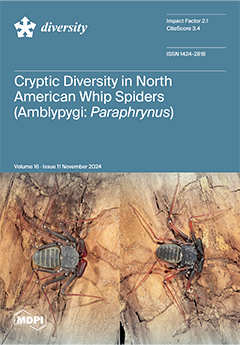In order to investigate non-cyanobacteria dominance succession from
Microcystis blooms, particularly to diatom dominance, an experiment using varying colonial
Microcystis biomasses expressed as bulk concentrations of 2.0, 4.0, 6.0, 8.0, 10.0, 12.0, 14.0, 16.0, 18.0, 20.0, 22.0, and 24.0 mL L
−1 was
[...] Read more.
In order to investigate non-cyanobacteria dominance succession from
Microcystis blooms, particularly to diatom dominance, an experiment using varying colonial
Microcystis biomasses expressed as bulk concentrations of 2.0, 4.0, 6.0, 8.0, 10.0, 12.0, 14.0, 16.0, 18.0, 20.0, 22.0, and 24.0 mL L
−1 was undertaken under continuous aeration mixing in a greenhouse during a hot summer where shading had reduced light level by 97%. The results showed that the algal shift process was affected by the initial biomass of the colonial
Microcystis, and the algal community diversified. When the
Microcystis bulk concentration was between 2.0 and 16.0 mL L
−1, the bloom became dominated by diatom
Nitzschia palea, which aggregated on the mucilage sheathes of the
Microcystis colonies. The diatom density at bulk concentration biomass of 2.0 mL L
−1 reached a maximum at 2.8 × 10
5 cells mL
−1 on day 27. When the bulk concentration was at 18.0–24.0 mL L
−1, no diatom dominance appeared. The shift from a
Microcystis bloom to diatom dominance was affected by the initial
Microcystis biomass, and the most suitable bulk concentration biomass for colonial
Microcystis was at 2–12 mL L
−1, in which the chlorophyll-
a level was about from 285 to 1714 μg L
−1. The mechanism underlying this algal shift may be that the low light and nutrient levels in the
Microcystis bloom promoted diatom aggregation growth on the mucilage sheaths of
Microcystis colonies under continuous aeration mixing.
Full article





